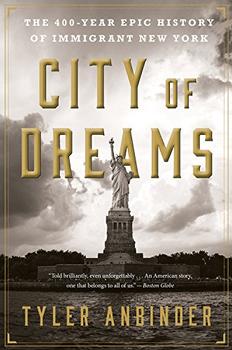Summary | Excerpt | Reviews | Beyond the Book | Readalikes | Genres & Themes | Author Bio

The 400-Year Epic History of Immigrant New York
by Tyler AnbinderPROLOGUE
As midnight drew near on New Year's Eve 1891, New Yorkers thronged lower Broadway. Its watering holes had been packed for hours, with revelers throwing back shots of whiskey, hot toddies, and eggnog as they prepared to brave the cold for the traditional outdoor countdown. It seemed as if every city resident, young and old, man and woman, native and newcomer, was out in the streets blowing a "fish horn," the favorite New Year's noisemaker of the era. In the final minutes before midnight, thousands surged out of the bars, brownstones, and tenements of lower Manhattan toward two traditional spots where New Yorkers had been celebrating this occasion for generations.
The largest crowd squeezed into City Hall Park, the nine-acre triangle of land that lies just east of Broadway and south of Chambers Street. "Flags floated over the City Hall," wrote a New York Times reporter who was there that night, and "small boys festooned the bare limbs of the trees; calcium lights shed a glare upon the crowd, and people pushed and jostled and tooted horns and gave each other good greeting." When the hands of the City Hall clock both reached twelve, a band positioned on the front steps struck up "Hail, Columbia." "Momentarily the fish-horn orchestra was dumb," noted the Times correspondent, as the crowd paid its respects to what was then considered the American "national song." (Only in 1931, by which point "Hail, Columbia" had fallen out of favor, did Congress designate "The Star-Spangled Banner" as the United States' first "national anthem.") The moment the band concluded the patriotic tune, the crowd "burst forth with redoubled fury. Men shouted, the band played, the elevated and bridge locomotives shrieked their welcome, and red lights were burned."
Barely a half mile to the south, thousands more gathered around Trinity Church, at the corner of Broadway and Wall Street, to partake of another New York tradition — hearing Trinity's famous bells "ring in" the New Year. Yet "the horn-blowing of the multitude" around the church was so deafening that "it was impossible to hear even the sounding of the hour of 12 by the 'Great Tom,' the mammoth of the chime of bells." On a normal night Great Tom could be heard as far away as Long Island and New Jersey. But on this occasion, the bell master's selection of "peals, triplets, roulades, carols, and the like" was completely drowned out by the din of the jubilant, drunken, raucous revelers.
At the stroke of midnight a mile farther south, seventeen-year-old Annie Moore was probably in her bunk in the aft starboard steerage compartment of the S.S. Nevada, which lay at anchor in New York Harbor off the southern tip of Manhattan. Somewhere close by were Annie's younger brothers, fifteen-year-old Anthony and twelve-year-old Philip. The three Moores, all natives of the city of Cork, were coming to New York to join their parents, Matthew and Julia, and their older siblings, twenty-one-year-old Mary and nineteen-year-old Cornelius, who had ventured to America four years earlier and were living in lower Manhattan at 32 Monroe Street, a few blocks from the waterfront, just north of the Brooklyn Bridge.
The Nevada was no luxury liner. It was an exceedingly low and narrow vessel, 346 feet long but only 43 feet wide at its broadest point, with one short exhaust funnel amidships and a mast fore and aft just in case the engines gave out. The ship had been plying the route from Liverpool to New York via Queens-town, County Cork, since 1869, just as steamships had begun to outnumber sailing ships on transatlantic crossings. The Nevada certainly was a sturdy ship; when it collided with the Romano in 1884, it was the other vessel that sank to the bottom of the Atlantic. But by 1891 it had clearly seen better days. The ship's steerage compartments had once overflowed with English, Irish, and Scandinavian immigrants, sometimes a thousand or more on a single voyage. On this journey, however, it held only 127 passengers, most of them impoverished Russian Jews fleeing discrimination and persecution in tsarist Russia. It took the Nevada eleven days to chug its way from Ireland to New York, while other ships could make the voyage in six. In 1891 the Nevada was a ship for those who could afford no better. Five years later, its owners would sell it for scrap.
Excerpted from City of Dreams: The 400-Year Epic History of Immigrant New York by Tyler Anbinder. Copyright © 2016 by Tyler Anbinder. Reprinted by permission of Houghton Mifflin Harcourt Publishing Company. All rights reserved.






Your guide toexceptional books
BookBrowse seeks out and recommends the best in contemporary fiction and nonfiction—books that not only engage and entertain but also deepen our understanding of ourselves and the world around us.